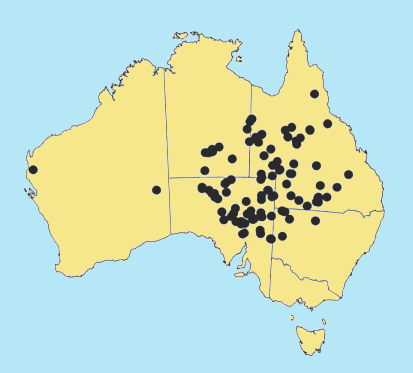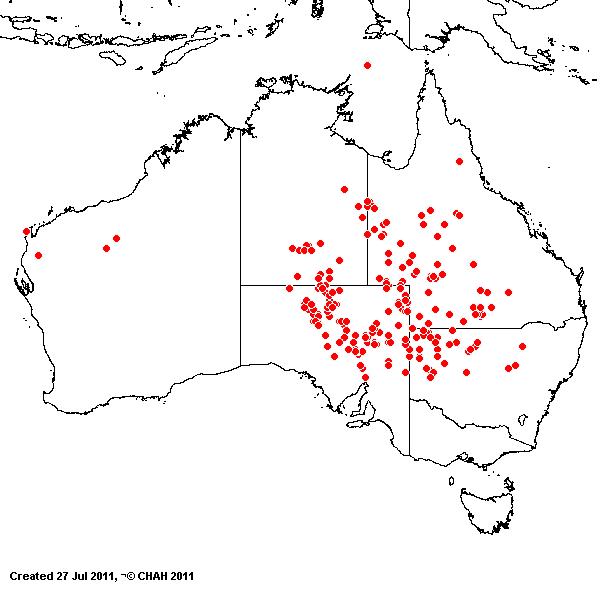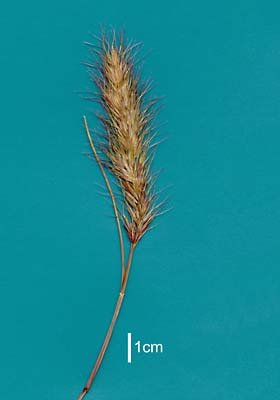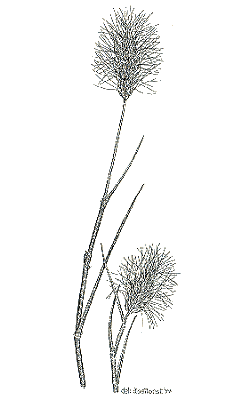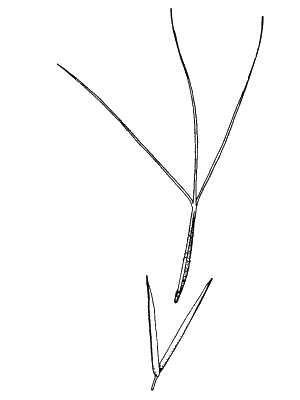Aristida anthoxanthoides (Domin)
Henrard. Meded. Rijks. Herb. Leiden 54: 29 (1926).
Classification. (GPWG 2001) : Subfamily Aristidoideae. Aristideae.
Basionym and/or
Replacement Name: Aristida
adscensionis var. anthoxanthoides Domin, Bibliotheca Botanica
85(2): 343, t. 15, f. 9–12 (1915).
Type of Basionym or
Protologue Information: HT: M. Koch 305, Oct 1899, Australia: South
Australia: Mt. Lyndhurst, Flinders Ranges station (K; IT: BRI (photo, fragm.)).
Recent synonyms:
Aristida adscensionis L. var. subaequiglumis Domin, Aristida
peregrina Henrard, Aristida depressa Retz.
Key references
(books and floras): [1878] G.Bentham, Flora Australiensis 7 (563 as Aristida
depressa), [1952] C.A.Gardner, Flora of Western Australia 1 Gramineae
(168), [1981] M.Lazarides in J.Jessop (ed)., Flora of Central Australia
(449), [2002] D.Sharp & B.K.Simon, AusGrass, Grasses of Australia,
[2006] J.Jessop, G.R.M.Dashorst, F.M.James, Grasses of South Australia
(318), [2008] S.W.L.Jacobs, R.D.B.Walley & D.J.B.Wheeler, Grasses of New
South Wales (126).
Illustrations:
[1952] C.A.Gardner, Flora of Western Australia 1 Gramineae (167,
Pl. 49), [1983] J.C.Tothill & J.B.Hacker, Grasses of Southern Queensland
(106(35)), [2006] J.Jessop, G.R.M.Dashorst, F.M.James, Grasses of South
Australia (318, Fig. 248), [2008]
S.W.L.Jacobs, R.D.B.Whalley & D.J.B.Wheeler, Grasses of New South Wales,
4th edn (126).
Derivation: Gk.
-oides, resembling. Similar to Anthoxanthum.
Habit. Annual.
Culms 15–30 cm tall, 2–3 -noded. Mid-culm internodes glabrous. Lateral branches
simple or sparsely branched or branched. Leaf-sheaths antrorsely scabrous,
glabrous on surface. Ligule a fringe of hairs, 0.5 mm long. Leaf-blades
straight, flat or conduplicate or involute or convolute, 4–9 cm long, 1.5 mm
wide. Leaf-blade surface scabrous, indumented.
Inflorescence.
Inflorescence solid, a panicle. Panicle oblong, 8 cm long, 2.5–4 cm wide.
Spikelets.
Spikelets pedicelled. Fertile spikelets 1-flowered, comprising 1 fertile
floret(s), without rachilla extension, lanceolate, terete, 5–7 mm long.
Glumes. Glumes
similar, thinner than fertile lemma. Lower glume lanceolate, membranous,
keeled, 1-keeled, 1 -nerved. Lower glume apex muticous. Upper glume lanceolate,
4–7 mm long, membranous, keeled, 1-keeled, 1 -nerved. Upper glume surface
smooth to scabrous. Upper glume apex entire or erose, mucronate.
Florets.
Fertile lemma 5–7 mm long, without keel, 3 -nerved. Lemma apex awned, 3 -awned.
Median (principal) awn without a column. Lateral lemma awns present. Palea
without keels. Anthers 3. Grain 5–6 mm long.
Continental
Distribution: Australasia.
Australian
Distribution: Western Australia, Northern Territory, South Australia,
Queensland, New South Wales.
Western Australia:
Helms, Fortescue, Ashburton, Carnarvon. Northern Territory: Central
Australia North, Central Australia South. South Australia:
North-western, Lake Eyre, Gairdner-Torrens Basin, Flinders Ranges, Eastern,
Eyre Peninsula. Queensland: Burke, Cook, Gregory North, Mitchell, North
Kennedy, Warrego, Gregory South. New South Wales: North-Western Plains,
North Far Western Plains.
Notes.
A. anthoxanthoides is different from all other species by the spiciform
panicle and annual habit.
Recorded for a few
isolated localities in Western Australia, but occurs mainly over most of the
arid parts of mainland Australia. Generally found on clay soils in Mitchell
grass plains (Astrebla spp) and alluvial soils. One of the more
palatable species of Aristida. Flowering and fruiting all year.
